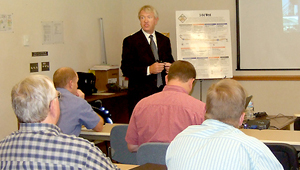
| CONNECTIONS |
IDAHO
ITD
HOME
511 TRAVEL SERVICES
IDAHO
DMV
ITD
NEWS
HIGHWAY
SAFETY
IDAHO STATE POLICE
STATE OF IDAHO
NIATT
NATIONAL
AASHTO
AAMVA
AAA of IDAHO
FEDERAL HIGHWAYS
FEDERAL AVIATION
IDAHO STATE POLICE
NHTSA
NTSB
TRB
U.S. DOT
TRANSPORTER
Archives
Milestones
Comments
Idaho
Transportation
Department
Office of Communications
P.O. Box 7129
Boise, ID 83707
208.334.8005
Fax: 208.334.8563

UDOT leader shares knowledge about
accelerated off-site bridge
construction, placement
When Jim McMinimee addressed representatives of ITD and the GARVEE Transportation Program in September, he brought the state one step closer to a new method of accelerated bridge construction.
Called Self-Propelled Modular Transport, the method uses heavy-duty rollers to transport prefabricated bridge segments into place within hours. ITD will use the technology in December to transport the new I-84, Robinson Boulevard and Black Cat Road bridges in Nampa and Meridian.
 The idea to use transporter technology as part of the bridge replacements began nearly two years ago during a three-day Federal Highway Administration workshop in Boise. Faced with an ambitious construction schedule for I-84 through the GARVEE Transportation Program, ITD applied to bring national leaders to discuss construction methods that could expedite the program.
The idea to use transporter technology as part of the bridge replacements began nearly two years ago during a three-day Federal Highway Administration workshop in Boise. Faced with an ambitious construction schedule for I-84 through the GARVEE Transportation Program, ITD applied to bring national leaders to discuss construction methods that could expedite the program.
“We asked ourselves, how can we reduce impacts to the traveling public despite a tremendous amount of highway construction in the valley?” said Dave Jones, ITD’s District 3 engineer.
“One of the answers was accelerated bridge construction,” Jones said. “We saw that other states had experienced enormous reductions in bridge closures through the technology.”
A Value Engineering Study later that year confirmed the Robinson and Black Cat projects on I-84 presented ideal opportunities to use the technology.
The old bridges were supported by multiple columns and prevented construction of additional lanes on I-84. Both were demolished recently.
ITD will build the new structures off-site and place them over the interstate in December for a January re-opening.
In addition to reducing bridge closures up to three months, the method also will help keep the larger I-84 widening project on schedule.
Traditional bridge construction would have slowed critical work on the widening project, delaying the entire project up to nine months.
“Advanced construction technology was an ideal solution,” Jones explained.
Meanwhile, Utah Director of Project Development Jim McMinimee was overseeing a rapid transition to accelerated bridge construction in Idaho’s neighboring state. Since 2002, Utah has replaced several bridges using self-propelled modular transporters similar to those ITD will use this winter.
McMinimee accepted an invitation last month to discuss his experience and recommendations with the ITD staff.
He shared years of knowledge with ITD staff and department leadership on Sept. 8. Workshop material covered traffic and construction considerations, quality and risks.
The main message, however, focused on involving the public.
“Don’t underestimate the level of interest that this type of technology will generate,” said McMinimee. “To transition from traditional methods to accelerated technology requires the buy-in and support of an entire community.”
The first bridge to be transported on-site in Utah attracted thousands of spectators who stayed all night to watch the bridges move into place, McMinimee said. He credited the successful event to months of advance planning, education and outreach.
The new Robinson and Black Cat bridges are scheduled to be moved on-site in early December.
Published 10-17-8